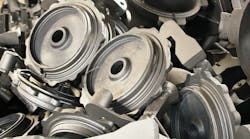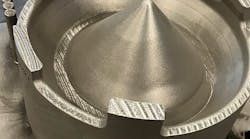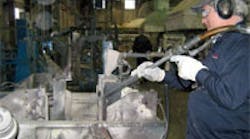Dry-ice blast cleaning technology has developed over several years, and for the metalcasting industry Cold Jet Inc.’s (www.coldjet.com) technique is proving to be a fast and easy way to eliminate labor-intensive scraping, chemical cleaning, or blasting with other media – which may create waste-disposal problems. In one success story, dry-ice blasting has cut cleaning time for permanent molds and related coreboxes by 60%. In most cases, the cleaning operation can be carried out with the objects remaining in place, eliminating time-consuming disassembly and reassembly.
Dry-ice blasting is similar to sand blasting or grit blasting: a medium is accelerated in a pressurized air stream to impact a surface to be cleaned or prepared. But, instead of using hard abrasive media to grind on (and possibly damage) a surface, dry-ice blasting uses soft dry-ice pellets, accelerated to supersonic speeds, to create “microexplosions” on the surface being cleaned. This lifts the undesirable material off the underlying substrate, and at the same time the dry-ice pellets dissipate into the atmosphere without generating secondary waste.
Dry ice is made by allowing pressurized liquid carbon dioxide (LCO2) to expand into the natural atmosphere. This causes the LCO2 to expand into both a gas vapor and solid snow. Then, the snow is compressed to form blocks, or compressed and extruded to form pellets. Dry-ice blasting uses the latter form; the pellets can be made on-site or supplied.
Cold Jet dry-ice blasting uses compressed air supplied at supply of at 80 psi and 50 scfm to accelerate dry-ice pellets to a high velocity. The company says the technique works because of three factors: factors: pellet kinetic energy, thermal shock effect, and thermal-kinetic effect.
Even at high-impact velocities and head-on impact angles, the kinetic effect of solid CO2 pellets is less than that of other media, such as sand or grit. This is due to the relative softness of a dry-ice pellet, which is neither as dense nor as hard as other projectile media. Also, the pellet changes phase from a solid to a gas almost instantaneously upon impact, which effectively provides an almost nonexistent coefficient of restitution in the impact equation. Very little impact energy is transferred into the coating or substrate, so the Cold Jet blasting process is considered to be nonabrasive.
Instantaneous sublimation (i.e., a phase change from solid to gas) of dry-ice pellet upon impact absorbs maximum heat from the very thin top layer of surface coating, or contaminant. Maximum heat is absorbed due to latent heat of sublimation.
The very rapid transfer of heat into the pellet from the coating top layer creates an extremely high temperature differential between successive micro-layers within the coating. This sharp thermal gradient produces localized high shear stresses between the micro-layers. The high shear produced over a very brief expanse of time causes rapid micro-crack propagation between the layers, leading to coating final bond failure at the surface of the substrate.
The combined impact energy dissipation and extremely rapid heat transfer between the pellet and the surface cause instantaneous sublimation of the solid CO2 into gas. The gas expands to nearly 800 times the volume of the pellet in a few milliseconds, the so-called “micro-explosion” at the point of impact.
Cold Jet has developed portable systems that can be readily moved to the cleaning site. With a welded steel frame, large flatfree tires, and ergonomic handles, the Aero series is sturdy, yet balanced and maneuverable. Every system is operator-friendly and engineered to be dependable, easy to use, and cost effective.










